Related Research Articles

Battle of Britain is a 1969 British war film directed by Guy Hamilton, and produced by Harry Saltzman and S. Benjamin Fisz. The film documents the events of the Battle of Britain. The film drew many respected British actors to accept roles as key figures of the battle, including Laurence Olivier as Air Chief Marshal Sir Hugh Dowding, Trevor Howard as Air Vice-Marshal Keith Park, and Patrick Wymark as Air Vice-Marshal Trafford Leigh-Mallory. It also starred Michael Caine, Christopher Plummer, and Robert Shaw as Squadron Leaders. The script by James Kennaway and Wilfred Greatorex was based on the book The Narrow Margin by Derek Wood and Derek Dempster.
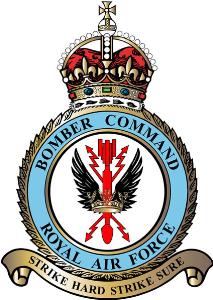
RAF Bomber Command controlled the Royal Air Force's bomber forces from 1936 to 1968. Along with the United States Army Air Forces, it played the central role in the strategic bombing of Germany in World War II. From 1942 onward, the British bombing campaign against Germany became less restrictive and increasingly targeted industrial sites and the civilian manpower base essential for German war production. In total 364,514 operational sorties were flown, 1,030,500 tons of bombs were dropped and 8,325 aircraft lost in action. Bomber Command crews also suffered a high casualty rate: 55,573 were killed out of a total of 125,000 aircrew, a 44.4% death rate. A further 8,403 men were wounded in action, and 9,838 became prisoners of war.
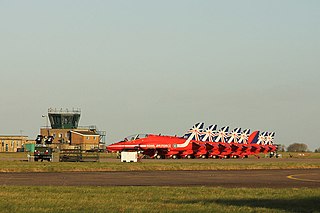
Royal Air Force Scampton or RAF Scampton is a Royal Air Force station located adjacent to the A15 road near to the village of Scampton, Lincolnshire, and 6 miles (9.7 km) north west of the city, Lincoln, England.

Royal Air Force Coningsby or RAF Coningsby, is a Royal Air Force (RAF) station located 13.7 kilometres (8.5 mi) south-west of Horncastle, and 15.8 kilometres (9.8 mi) north-west of Boston, in the East Lindsey district of Lincolnshire, England. It is a Main Operating Base of the RAF and home to three front-line Eurofighter Typhoon FGR4 units, No. 3 Squadron, No. 11 Squadron and No. 12 Squadron. In support of front-line units, No. 29 Squadron is the Typhoon Operational Conversion Unit and No. 41 Squadron is the Typhoon Operational Evaluation Unit. Coningsby is also the home of the Battle of Britain Memorial Flight (BBMF) which operates a variety of historic RAF aircraft.

The Lincolnshire Aviation Heritage Centre is an aviation museum in East Kirkby, Lincolnshire, England. It was opened to the public in 1988 by Lincolnshire farmers Fred and Harold Panton, as a memorial to their older brother, Christopher Whitton Panton, who was killed on operations during the Second World War.

Royal Air Force East Kirkby or more simply RAF East Kirkby is a former Royal Air Force station near the village of East Kirkby, south of Horncastle in Lincolnshire, just off the A155. The airfield is now home to the Lincolnshire Aviation Heritage Centre air museum.

Royal Air Force Grimsby or more simply RAF Grimsby is a former Royal Air Force station located near Grimsby, Lincolnshire, England. The site was operational during the Second World War as part of RAF Bomber Command initially as a satellite station for the Vickers Wellington bombers of RAF Binbrook. By early 1943 the station was equipped with Avro Lancaster bombers of No. 100 Squadron RAF.

Royal Air Force Hemswell or more simply RAF Hemswell is a former Royal Air Force (RAF) station located 7.8 miles (12.6 km) east of Gainsborough, Lincolnshire, England.
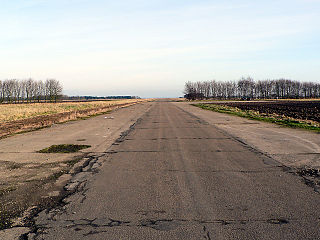
Royal Air Force Metheringham or more simply RAF Metheringham is a former Royal Air Force station situated between the villages of Metheringham and Martin and 12.1 mi (19.5 km) south east of the county town Lincoln, Lincolnshire, England.
Bruce Barrymore Halpenny was an English military historian and author, specialising in airfields and aircraft, as well as ghost stories and mysteries. He was also a broadcaster and games inventor.
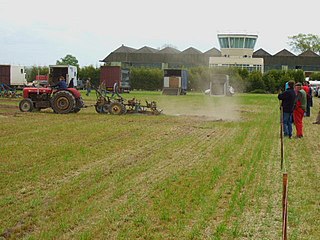
Royal Air Force Station Lindholme or more simply RAF Lindholme is a former Royal Air Force station in South Yorkshire, England. It was located 3.9 miles (6.3 km) south of Thorne and 6.9 miles (11.1 km) north east of Doncaster and was initially called RAF Hatfield Woodhouse.

Royal Air Force Elsham Wolds or more simply RAF Elsham Wolds is a former Royal Air Force station in England, which operated in the First World War and the Second World War. It is located just to the north east of the village of Elsham in north Lincolnshire.
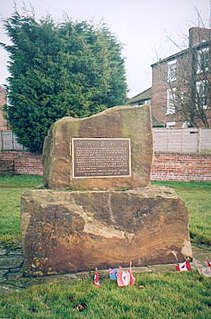
Royal Air Force station Skipton-on-Swale or more simply RAF Skipton-on-Swale is a former Royal Air Force station operated by RAF Bomber Command during the Second World War. The station was located at Skipton-on-Swale 4 miles (6.4 km) west of Thirsk, North Yorkshire, England. The village of Sandhutton is located just to the east. RAF Skipton-on-Swale was a sub-station of RAF Leeming.

Royal Air Force Bardney or RAF Bardney is a former Royal Air Force station located 1.7 miles (2.7 km) north of Bardney, Lincolnshire, England and 10.2 miles (16.4 km) east of the County town of Lincoln. It was built as a satellite to RAF Waddington in 1943 and the airfield closed in 1963.
Royal Air Force Thornaby or more simply RAF Thornaby was a former Royal Air Force Station located near the town of Thornaby-on-Tees, in the North Riding of Yorkshire, England. Fighter Command, Bomber Command and Coastal Command all operated from the base over its history, but its stint under Coastal Command is what the base was notable for, particularly in the air-sea rescue environment and the development of the Thornaby Bag. This was an emergency bag dropped to downed aircrew at sea and contained food, cigarettes and drink.
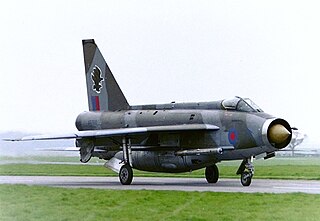
Royal Air Force Binbrook or RAF Binbrook was a Royal Air Force station, now closed, located near Binbrook, Lincolnshire, England. The old domestic site has been renamed to become the village of Brookenby. RAF Binbrook was primarily used by Bomber Command in the Second World War. The Central Fighter Establishment moved to Binbrook from RAF West Raynham between 1959 and 1962 and two English Electric Lightning squadrons were stationed there between 1965 and 1988.
Royal Air Force Skellingthorpe or more simply RAF Skellingthorpe is a former Royal Air Force station which was operational during the Second World War. It was located just west of the city of Lincoln, England about 2.5 miles (4 km) south-east of the village of Skellingthorpe on a field previously called Black Moor. After its closure the site was developed as the Birchwood estate.
Royal Air Force Doncaster or more simply RAF Doncaster, also referred to as Doncaster Aerodrome, is a former Royal Air Force station near Doncaster, South Yorkshire, England.

The Type-C hangar is a specific design of aircraft hangar built by the Royal Air Force during its expansion period of the 1930s. The hangar type generally measured 300 feet (91 m) in length, with a width of 152 feet 5 inches (46.46 m), and a clear height of 35 feet 4 inches (10.77 m). Whilst the type was designed, built and used during the expansion programme, installation of type-C hangars continued into the Second World War. By 1944, it was determined that at least one type-C hangar existed in 64 RAF expansion period airfields, which were open at that time.
References
- 1 2 3 To Shatter the Sky: Bomber Airfield at War – Book Review by Martin Bensley – The Standard – Friday, 20 April 1984 pages 16–17
- ↑ War Life on bomber stations in county – Lincolnshire Echo – Monday, 9 April 1984
- ↑ Don't miss Barry's TV take off – Front page – The Standard – Friday, 11 November 1983